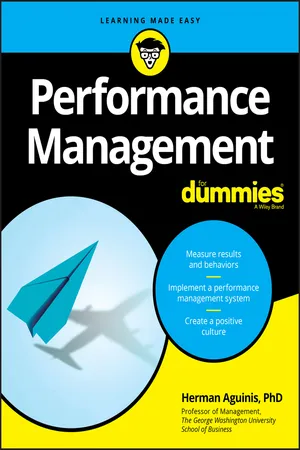
- English
- ePUB (mobile friendly)
- Available on iOS & Android
Performance Management For Dummies
About This Book
Implement best-in-class performance management systems
Performance Management For Dummies is the definitive guide to infuse performance management with your organization's strategic goals and priorities. It provides the nuts and bolts of how to define and measure performance in terms of what employees do (i.e., behaviors) and the outcome of what they do (i.e., results) —both for individual employees as well as teams.
Inside, you'll find a new multi-step, cyclical process to help you keep track of your employees' work, identify where they need to improve and how, and ensure they're growing with the organization—and helping the organization succeed. Plus, it'll show managers to C-Suites how to use performance management not just as an evaluation tool but, just as importantly, to help employees grow and improve on an ongoing basis so they are capable and motivated to support the organization's strategic objectives.
- Understand if your performance management system is working
- Make fixes where needed
- Get performance evaluation forms, interview protocols, and scripts for feedback meetings
- Grasp why people make some businesses more successful than others
- Make performance management a useful rather than painful management tool
Get ready to define performance, measure it, help employees improve it, and align employee performance with the strategic goals and priorities of your organization.
Frequently asked questions
Information
Getting Started with Performance Management
Introducing Performance Management



Why Do You Need Performance Management? To Succeed (of Course)
- Continuous process: Performance management is ongoing. It involves a never-ending process of setting goals and objectives, observing performance, and giving and receiving ongoing coaching and feedback.
- Alignment with strategic goals: Performance management requires that managers link employees’ activities and outputs with the organization’s goals. Making this connection helps the organization gain a competitive advantage because performance management creates a direct link between employee and team performance and organizational goals, and makes the employees’ contributions to the organization explicit.
Why performance management is alive and well
Imagining an organization without performance management
- Connect the behaviors and results produced by employees to your organization’s strategic priorities.
- Make fair and appropriate administrative decisions such as promotions, salary adjustments, and terminations.
- Inform employees about how they are doing and provide them with information on specific areas that need improvement.
- Give employees information on expectations of peers, supervisors, customers, and the organization, and what aspects of work are most important.
- Give employees information about themselves that can help them individualize their career paths. For example, if they don’t know their strengths, they cannot chart a more successful path for their future.
- Learn who are your high-potential and star performing employees.
- Anticipate where you will need to hire people and with which particular skill set.
- Evaluate the effectiveness of HR initiatives. For example, you don’t have accurate data on employee performance to evaluate whether employees perform at higher levels after participating in a training program.
Making Performance Management Work in Your Business
Distinguishing performance management from performance appraisal
Table of contents
- Cover
- Table of Contents
- Introduction
- Part 1: Getting Started with Performance Management
- Part 2: Designing an Effective Performance Management System
- Part 3: Implementing Performance Management Effectively
- Part 4: Connecting Performance Management with Rewards and the Law
- Part 5: The Part of Tens
- Index
- About the Author
- Connect with Dummies
- End User License Agreement
